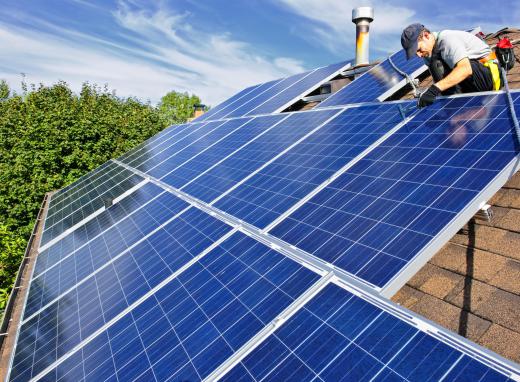What is Amorphous Silicon?
 Karyn Maier
Karyn Maier
Amorphous silicon is form of silicon, the second most abundantly occurring natural element on Earth. However, it differs from silicon in that it is non-crystallized and disordered in the same way that ordinary glass is, meaning that some of the atoms in its chemical structure resist bonding. These so-called “dangling” bonds impact the inherent properties of the material, namely giving it a higher defect density, which refers to the amount of naturally occurring imperfections. This substance, often abbreviated to a-Si, still offers several advantages over crystalline silicon that makes it preferable for use in manufacturing thin films for coating a variety of electronic components, particularly photovoltaic (PV) systems. For instance, it can be applied to large areas in a more homogeneous manner than silicon and at very low temperatures, allowing it to adhere to glass, plastic, and metals.
Before amorphous silicon can be applied as a thin film to certain materials, such as solar cells, it has to go through hydrogenation to lend the material greater stability and durability. This means that the dangling bonds must undergo “passivation,” a process in which the unordered bonds in each layer of silicon cells are saturated with atomic hydrogen while under pressure between layers of transparent conductor and a metal backing, usually tin oxide and aluminum, respectively. This modification allows for greater flexibility in terms of how the material may be deposited, as well as offering more control over its voltage properties. As a result, amorphous silicon can be used in thin film processes employed to make a variety of low-voltage devices, such as pocket calculators and watches.

Another advantage of utilizing amorphous silicon thin film over crystalline silicon is that the former absorbs up to 40 times more solar radiation. That being the case, only a very thin film coating is necessary to absorb 90 percent or more of direct sunlight. In fact, the coating only has to be 0.000 039 37 inch, or one micrometer in thickness. To put this into perspective, a single strand of human hair has a thickness 100 times greater. This attribute adds to the cost effectiveness of using amorphous silicon in thin film technologies.
The only drawback to using amorphous silicon in solar cell applications is something known as the Staebler-Wronski effect. For reasons not completely understood, the cells in the material tend to decrease voltage output by up to 20 percent after initial exposure to natural sunlight. However, the material does reach a point of electrical output stability after one to two months.
AS FEATURED ON:
AS FEATURED ON:











Discussion Comments
Is silicon extracted from the natural mines consider amorphous?
The resources that we use to produce manufactured products are becoming wider and wider. If silicon is the second most common natural element on Earth, hopefully we'll find many more uses for this resource. How abundant is the kind of silicon called amorphous silicon?
I always wonder about these natural elements that are abundant and are put into products that people use. Has the safety of silicon been tested thoroughly? How about the process of hydrogenation? I always think of asbestos and how long it was used in homes before they decided it was toxic to humans.
Post your comments